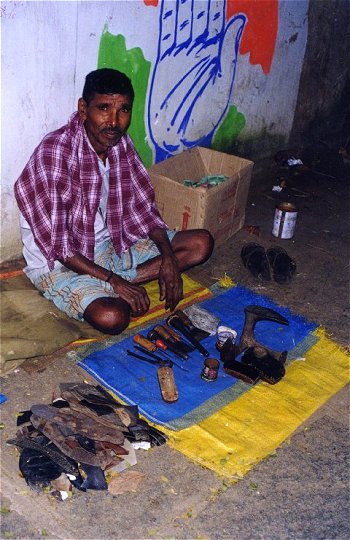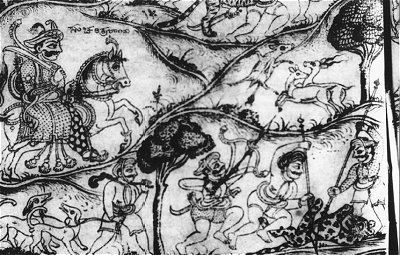The Caste System
The Caste System: Introduction, Myths and Reality
by Vikas Kamat
First Online: May 01, 2004
Page Last Updated: December 07, 2024
Introduction to Caste System of India
While caste system is not an area of my expertise, I am writing this introduction by popular request. I have based the following information on my personal studies and experiences while growing up in India (and later), and my primary motive is to correct some of the stereotyping that goes on about the caste system (example: there are four categories), while confirming some of the unsaid rules of the practice.
-Vikas Kamat
Caste, Varna and Jati
Before we dwell too deep, it is important to understand the history and meaning of the terms. The word varna (literally meaning color) is used in Hindu philosophies to describe the nature (swabhava) of a man (see: Who is a Brahmin?) It initially had to do with the sophistication and spiritual refinement of a man, and quickly got attached to the profession of a man.
The word jati indicates ethnicity of a person. Asking for one's jati is like asking about one's heritage.
The word caste, coined by Europeans probably meaning to say chaste (from English) or casta (from Portuguese), is used very commonly to refer to one's lineage. So it is much more closer to jati than varna.
Due to the delicate differences, and their intricate relationships --the professions were equated to the nature, and since India had a system of inheriting the parent's profession, the words varna, jati and caste became synonyms in the course of time.
The Four Layers
The caste layers most often quoted are:
-
The Brahmins -- those engaged in sacrifices, and priestly functions
-
The Kshtriyas -- Rulers and warriors
-
The Vaishyas -- Merchants, farmers, and tradesmen
-
The Shudras -- Laborers, craftsmen, service professions
One of the first references to the four categories of the caste system are found in the Bhagawad-Gita, where Krishna advises the brahmins to be learned, the warriors (kshartiyas) to be brave, vaishyas to be good merchants taking care of cattle and farmlands and the shudras to be faithful servants.
Notice that in the above list, the caste is associated with a profession. The Bhagawad-Gita also offers classification of men based on their predominant nature - satva (virtue), rajas (passion), and tamas (ignorance), and in the course of time, these qualities (gunas) got mapped on to the four layers, associating the brahmins with virtue and shudras with ignorance.
The Dalits
The biggest concern for students of the caste system is the status of people, so called Dalits. For centuries, a segment of the India society was condemned as caste-less and were denied access to temples, water, and other civil amenities. Gandhi, who fought very hard for betterment of this segment, called them Harijans or Children of God. Over a period of time, even the word Harijan has become politically incorrect, and these days are referred to as Dalits or Scheduled Castes.
© K. L. Kamat

Condemned Professions

Professionals such as janitors, and cobblers were/are discriminated in India in
the name of the caste system
See: Geographica Indica: The Dalits
The Caste System is Complex. Very Complex.
The caste system is a relative system - that means any prejudice or hierarchy can come into existence only with respect to another caste. Most people do not understand it and use the commonly available four category classification. In my own experiences, I have discovered that each sub-caste or community thinks that they are superior to others. I find it very hilarious. For instance, the Saraswats think they are superior to Goud Saraswats, and vice versa. The Daivajna community, who practice gold-smithy, consider themselves superior to Acharis, who are temple builders. I get email all the time from Christians and Lingayats (supposedly casteless faiths) claiming brahmanical ancestry.
© K. L. Kamat

Initiation of a Brahmin Boy
Those who study Indian culture will quickly discover that most of the culture involves all the communities. Both Hindu epics Ramayana and Mahabharata revolve around Kshatriya leaders. Lord Krishna is often identified as a Yadava (milkman of lower birth). Sage Vishwamitra, who is supposed to have coined the Gayatri mantram, was a meat eater, so were Buddha, and Swami Vivekananda.
© K. L. Kamat

Indian culture is abundant with non-brahmin traditions
Shown above, a hunting scene.
The Europeans who ruled India, brought with them their own class system of beaurocrats, aristocrats and commoners, and mapped to the already myriad of castes in India, giving rise to all kinds of fusion, prejudice, and unfair practices.
![]()
The Caste System: Myths and Reality
Myth 1: There are four castes in India
Reality: The four castes that are often mentioned derive from a the chaturvarna (four layered social order) that is mentioned in ancient Hindu scriptures. The Bhagavad-Gita defines what the four orders are, depending on the nature of the person. However we see that throughout history more than four castes have been in vogue, especially the fifth caste, the asprushya or untouchables, who were considered not worthy of a caste.
In today's India there are thousands of castes. In the list of Brahmin communities alone, I was able to list over forty-five different castes!
![]()
Myth 2: The Upper-castes (Brahmins) exploited the lower-castes for economic gain
Reality: The brahmins, while considered high on the social strata, actually led priestly and humble lives -- the doctrine called for that. The power and the wealth was mostly controlled by the kshatriyas and the trade was conducted by the vaishyas. Almost all of the Hindu kings in India's history belonged to the warrior community.
![]()
Myth 3: The Caste system led to slavery
Reality: Indeed the caste system was used for exploitation and abuse. However slavery, as was practiced in Europe and America was not practiced in India. The bonded-labor system, the servant system while can be argued as a form of slavery, is not same as the slavery of Africans to which the term is closely tied.
![]()
Myth 4: The caste system is on the decline
Reality: On the contrary. Due the complex social development and prevailing conditions of post-independent India, the caste system has morphed, and even developed. Every Indian knows about his or her own caste as well as the caste of one's acquaintances. Caste is a deciding factor in decisions involving marriage, job opportunities, and religious sacraments. Perhaps it is more accurate to say "discrimination based on caste system is on the decline". However, the forced equality has resulted in reverse discrimination in India, and resulted in large scale migration of upper-castes to other countries during 1980s and 1990s.
![]()
Myth 4: The lower-castes are an exploited minority
Reality: The word minority is inaccurate. In all the states of India, the so called lower-castes constitute majority in terms of population, and elected representation.
![]()
Myth 4: The lower-castes want to be recognized as equals
Reality: For political and materialistic reasons, many communities wish to be classified as lower-castes. In the 1980s there were agitations and violence in India, as some communities were classified as no-longer backward, and the Government was forced to reclassify them as disadvantaged.
![]()
See Also:
-
Children of the Forest God -- Learn about the little known, but very rich traditions and cultures of the tribals of India
-
The Brahmins -- Potpourri of topics on the various brahmin communities of India; includes a number of pictures and a comprehensive list of priestly communities.
-
Castes of Ramayana -- A complete list of professions mentioned in Ramayana provides insight into the caste system of India.

